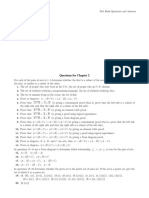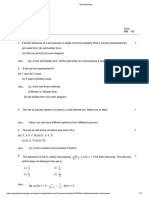0% found this document useful (0 votes)
36 views11 pagesCao Question and Answer Solution
This document contains solutions to mathematical set theory problems. It provides answers to 30 questions about sets, subsets, unions, intersections, complements and other set operations. Detailed explanations and proofs are given for many of the solutions.
Uploaded by
23030185Copyright
© © All Rights Reserved
We take content rights seriously. If you suspect this is your content, claim it here.
Available Formats
Download as PDF, TXT or read online on Scribd
0% found this document useful (0 votes)
36 views11 pagesCao Question and Answer Solution
This document contains solutions to mathematical set theory problems. It provides answers to 30 questions about sets, subsets, unions, intersections, complements and other set operations. Detailed explanations and proofs are given for many of the solutions.
Uploaded by
23030185Copyright
© © All Rights Reserved
We take content rights seriously. If you suspect this is your content, claim it here.
Available Formats
Download as PDF, TXT or read online on Scribd
/ 11
























































